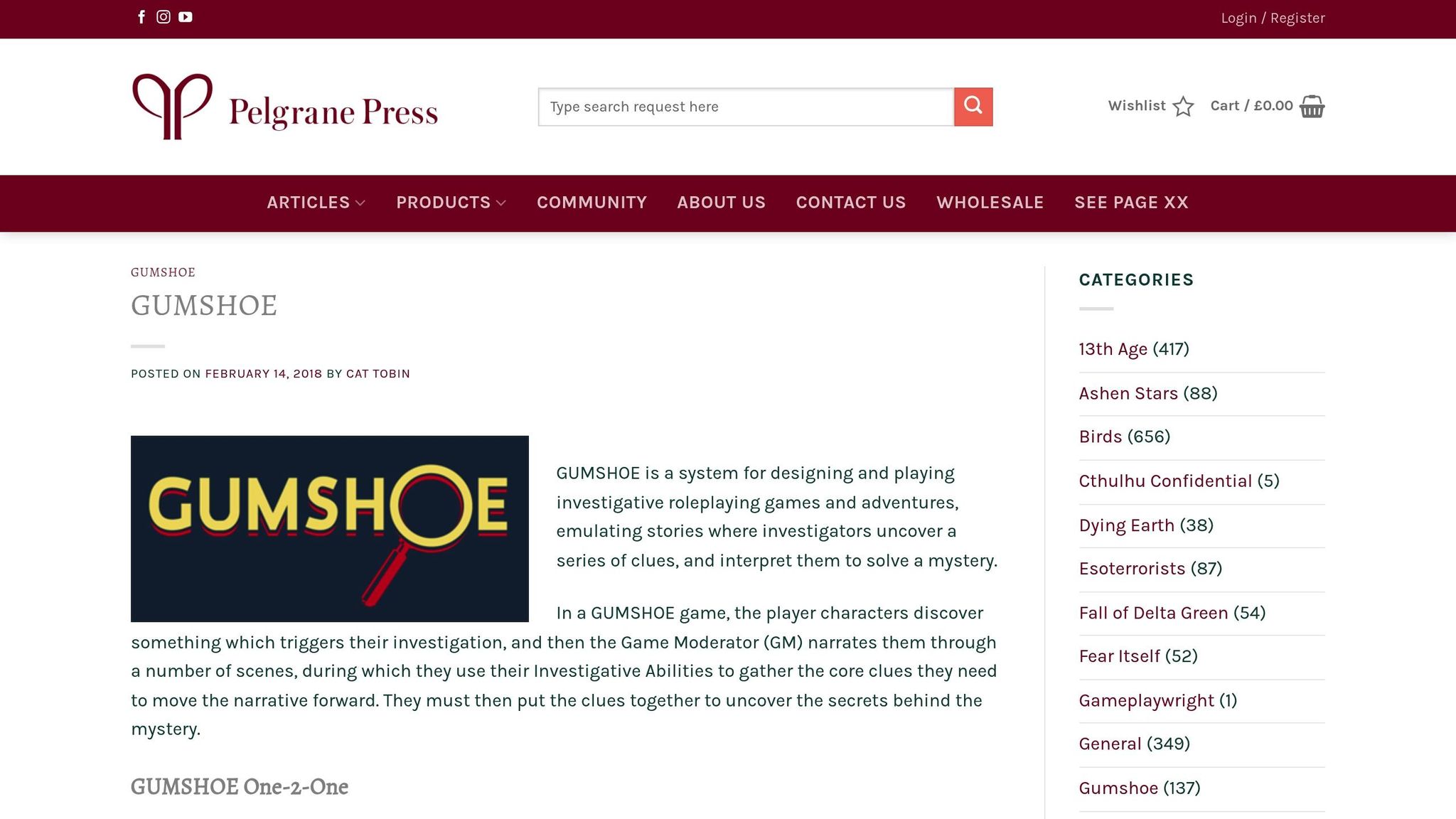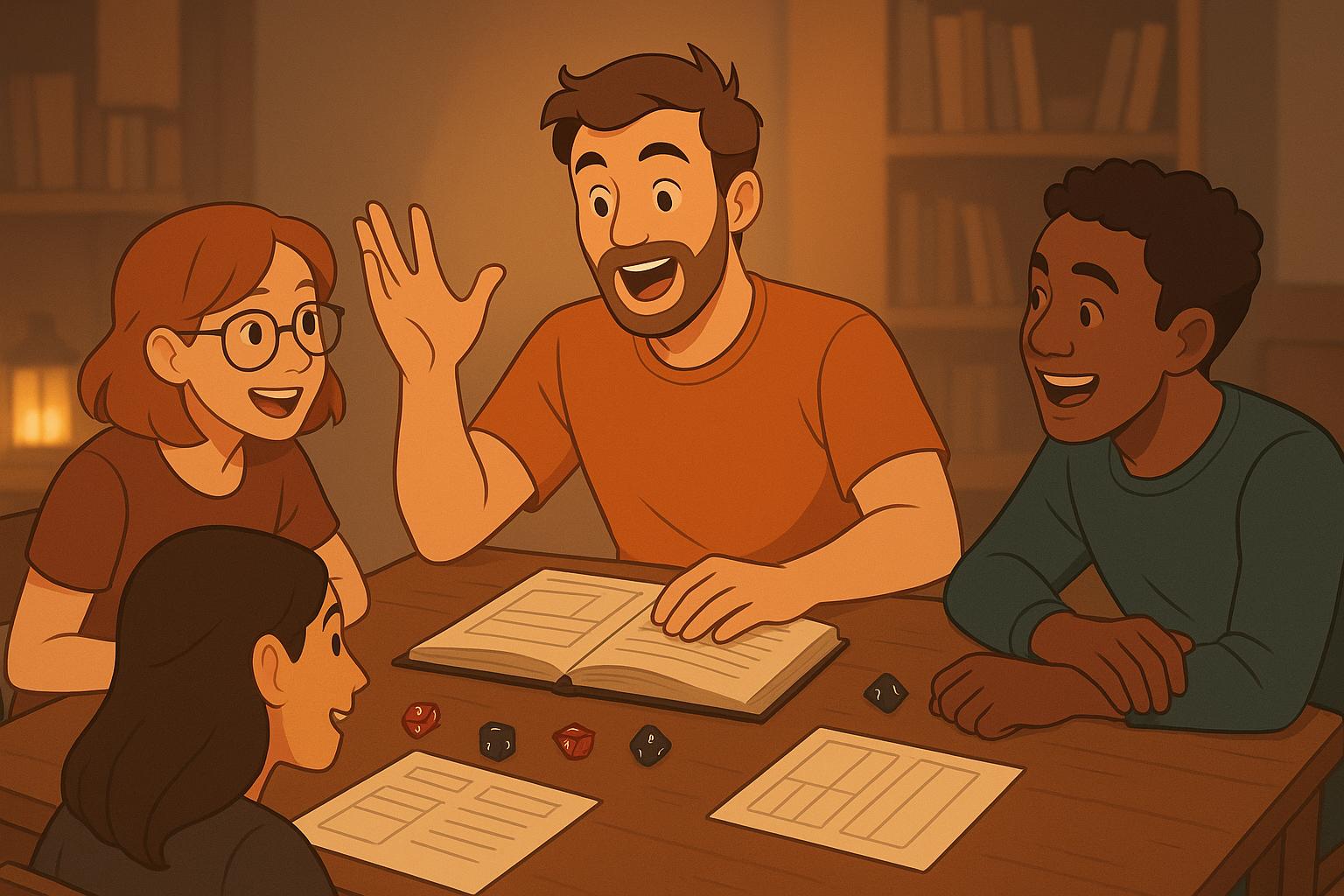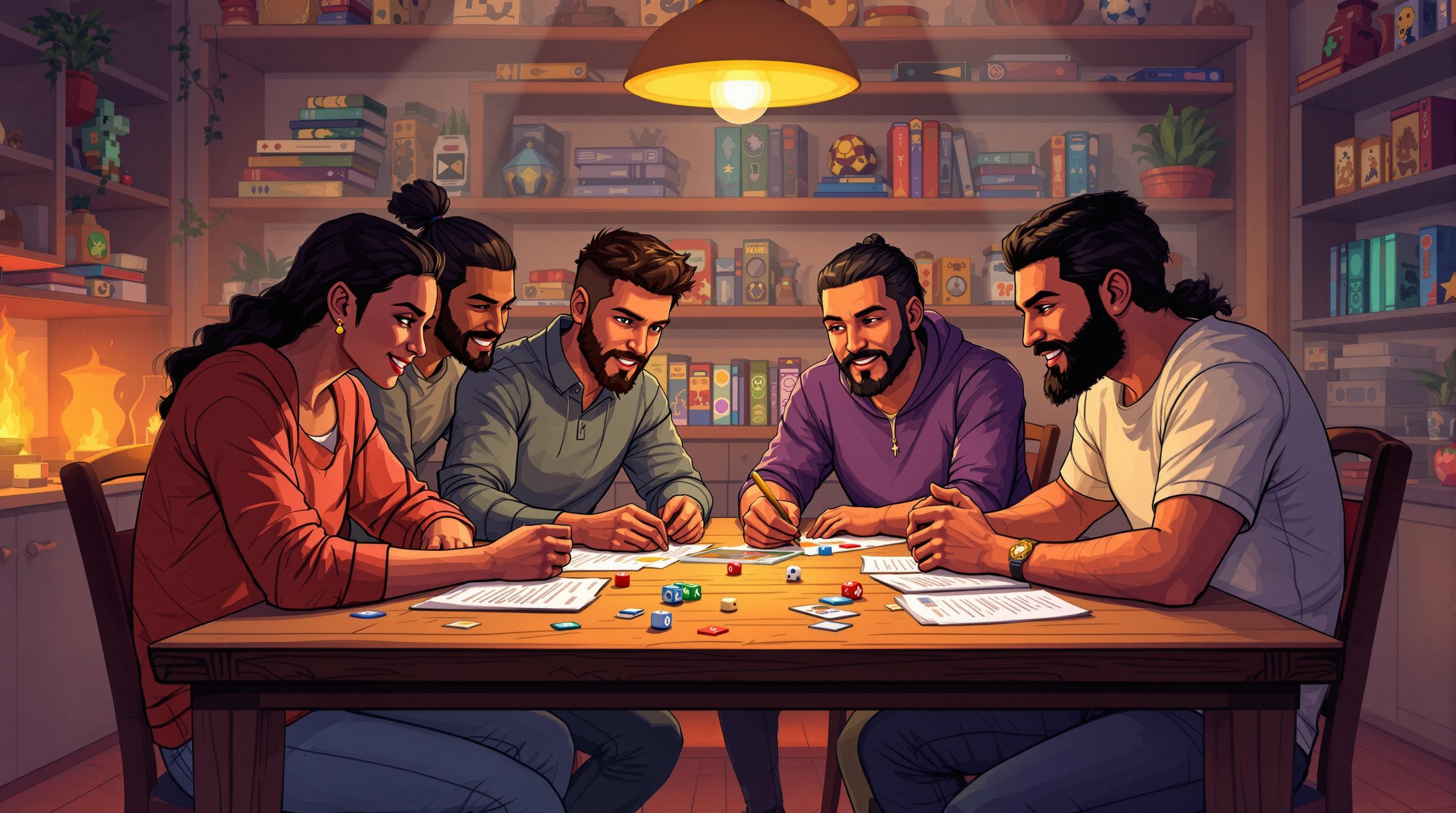TimeWatch RPG is a tabletop role-playing game where you play as time-traveling agents tasked with protecting history. Using a streamlined version of the GUMSHOE system, the game focuses on solving timeline disruptions while managing the risks of paradoxes and Chronal Stability. Here's what makes it unique:
-
Core Mechanics:
- Timecraft skill to detect anomalies.
- Chronal Stability to track your existence in the timeline.
- Paradox Tests to handle contradictions.
- Stitch Tokens to reward creative problem-solving.
-
Historical Gameplay:
- Change or protect key events using the Inertia Rating (IR) system.
- Reimagine historical figures like Joan of Arc as time agents.
-
Campaign Design:
- Missions follow three phases: Detection, Investigation, Resolution.
- Tools like timeline cards and anchor events help manage complex time-travel stories.
This game blends history, science fiction, and strategy to create a dynamic, engaging experience. The core rulebook is available for $24.95, making it an accessible entry point for time-travel RPG fans.
Doctor Who RPG - Twelfth Doctor Core Rulebook Deep-Dive
Game Mechanics
TimeWatch RPG takes the foundation of the GUMSHOE system and adds a time travel twist, blending investigative gameplay with temporal adventures. Let’s break down how the system adapts to the unique challenges of time travel.
GUMSHOE System Basics

TimeWatch streamlines the original system by narrowing over 28 abilities down to just 12 core skills. Among these, Timecraft stands out. Every agent gets a free starting point in this skill, allowing them to detect timeline anomalies without needing to roll dice. This keeps the GUMSHOE philosophy intact - ensuring players never miss crucial clues - while adding a time-travel spin.
Instead of traditional sanity mechanics, TimeWatch introduces Chronal Stability. This resource, which starts at a value equal to an agent’s Chronal Resistance stat, measures how well characters hold their place in the timeline. If Stability drops below zero, agents experience the "fading" effect, where they slowly disappear from existence. Managing this resource becomes critical as players navigate the dangers of time travel.
Handling Time Paradoxes
TimeWatch introduces an engaging system to address temporal contradictions: Paradox Tests. To resolve these, players roll a d6 against a base difficulty of 4. A failed roll - often the result of actions like using advanced future tech - costs 4 Chronal Stability points. However, players can mitigate this risk by spending Paradox Prevention points, which grant a +3 bonus to the roll. As highlighted in the 2019 Plane Sailing review, this mechanic discourages frivolous "time tourism" while allowing for impactful, dramatic moments when the stakes are high.
The Reality Anchor ability adds another layer of strategy. Agents with this skill can stabilize teammates by spending points to restore their Chronal Stability on a 1:1 ratio. This creates "temporal tanks" capable of absorbing the fallout from timeline disruptions.
Another standout feature is the introduction of Stitch tokens, a meta-currency system that rewards players (up to 3 tokens per session) for creative problem-solving. These tokens can be spent to refresh ability pools, automatically succeed on Timecraft tests, or even establish temporary "save points" in the timeline.
This combination of mechanics ensures that time travel in TimeWatch feels both thrilling and meaningful. Players are equipped with the tools to navigate the intricate cause-and-effect web of temporal adventures while facing real consequences for their actions.
History and Fiction
TimeWatch RPG merges historical events with science fiction, allowing players to manage paradoxes while immersing themselves in richly detailed worlds. Let’s delve into how timeline changes and historical figures are woven into the gameplay experience.
Timeline Changes
TimeWatch introduces the concept of a Paradox Threshold, using a "river-of-time" metaphor to illustrate how even small actions can ripple through history. The game’s Stitch system gives players a 3–5 session window to resolve anomalies. To quantify the difficulty of altering events, the game employs an Inertia Rating (IR) system: major historical milestones like World War II have high IR ratings, requiring multiple successes, while smaller events are easier to influence. For instance, preventing President Lincoln's assassination would require an IR of 4 (on a scale of 1–5) and could cost players at least 6 Chronal Stability points.
In the adventure "The Clockwork Cathedral", players witness how seemingly minor actions - such as providing Brunelleschi with modest technological help - can have far-reaching effects on the timeline.
Historical Characters
TimeWatch also brings historical figures to life through the Reality Anchor ability, which requires a minimum of 4 points. This feature adds depth to the narrative and creates strategic consequences during gameplay.
Some historical figures are reimagined with fascinating twists:
| Historical Figure | TimeWatch Alternative History |
|---|---|
| Joan of Arc | Joins TimeWatch instead of being executed in 1431 CE |
| Richard Owen | Classifies dinosaurs while under the influence of psychic velociraptors in 1841 CE |
| Anne Boleyn | Escapes execution to become a time-traveling operative |
These creative reinterpretations have significant effects on the timeline. The Mediterranean Mesh supplement emphasizes sensitivity to different cultures by incorporating History checks and adaptive chronomorphic disguises.
For Game Masters (GMs), the Timeline Toolkit offers a robust framework with three key elements: historical pivot points, tools for detecting anachronisms, and paradox vectors for mission design. Players can also use the Preparedness ability to navigate historical settings, relying on basic Wikipedia-level knowledge or opting for "Deep History" rules for a more academic approach.
sbb-itb-b8b00a5
Running Time Travel Campaigns
TimeWatch campaigns thrive on well-managed timelines and compelling storytelling. Game Masters (GMs) have tools at their disposal to balance historical authenticity with player-driven choices, ensuring an engaging experience.
Mission Structure
TimeWatch missions are built around a three-phase structure that keeps the story flowing while handling the intricacies of time travel. Each phase involves specific tasks, checks, and player decisions:
| Phase | Core Activities | Required Checks |
|---|---|---|
| Detection | Spot timeline anomalies | Timecraft (DC 4–6) |
| Investigation | Collect historical evidence | History, Science! (3–5 clues) |
| Resolution | Fix disruptions in the timeline | Chronal Stability (8+ points) |
To maintain consistency in the timeline, GMs can use the "Anchor Event" system. For instance, in the official campaign Behind Enemy Times, players traverse five interconnected eras, protecting key historical moments while influencing secondary events. GMs are advised to anchor one fixed event per era while allowing 2–3 secondary events that players can alter.
The structure works best with these session guidelines:
- Groups of 3–5 players
- Sessions lasting 2–3 hours
- Dividing each historical era into 45-minute segments
Using Stitch Mechanics
The Stitch system adds another layer of depth to gameplay by rewarding players for inventive problem-solving. Every session begins with 3 Stitches, which can be replenished through roleplay at a rate of 1 Stitch every 30 minutes.
The "Temporal Ingenuity" reward system provides bonus Stitches for creative solutions, such as:
- Using era-specific technology in unexpected ways (+1)
- Designing paradox loops that sustain themselves (+2)
- Resolving conflicts without resorting to additional time jumps (+3)
To avoid overwhelming scenes, GMs should cap Stitches at 3 per scene. Players can also exchange 5 Stitches for 1 Chronal Stability point, with a maximum gain of +3 per session. This creates opportunities for strategic play and resource management.
For campaigns spanning multiple eras, GMs can use color-coded timeline cards to simplify tracking:
- Red: Fixed historical events
- Yellow: Mutable events
- Green: Outcomes shaped by players
This method was particularly effective in a 12-mission campaign, where players averaged 18 Stitches per mission. This led to notable character growth, with improvements in Chronal Stability and access to advanced temporal abilities.
Additionally, the GUMSHOE system ensures that clues are automatically revealed, while Chronal Stability rules introduce meaningful risks and rewards. GMs should also monitor paradox difficulty classes, increasing the challenge level every 5 missions. These mechanics collectively enhance the storytelling experience, making each mission a dynamic and memorable adventure.
TimeWatch Game Features
TimeWatch RPG offers a standout experience by combining time-travel mechanics with a strong focus on storytelling. The game goes beyond just exploring history - it emphasizes the ripple effects of altering the timeline. Players dive into temporal investigations, making deliberate choices that can reshape history. Every decision carries weight, pushing players to think carefully as they navigate through ever-changing historical events. This blend of intricate storytelling and the excitement of time travel creates a tabletop adventure like no other.
Summary
Main Points
TimeWatch RPG stands out by combining time travel, historical intrigue, and investigative gameplay. Built on the GUMSHOE system, it ensures players can always uncover critical clues, while the Chronal Stability mechanic introduces consequences for tampering with timelines, encouraging thoughtful decisions. The Stitch system adds another layer of strategy, rewarding players for creative problem-solving through clever token management.
By weaving historical events with futuristic challenges, TimeWatch RPG pushes players to consider the ripple effects of their actions. Campaigns range from protecting the integrity of timelines to exploring alternate histories, offering endless storytelling possibilities. This snapshot highlights how TimeWatch RPG merges strategic gameplay with dynamic narratives, creating a rich experience for players.
Additional Resources
If you're intrigued by time travel tabletop games, the TTRPG Games Directory provides a detailed catalog of similar titles, including insights into TimeWatch's mechanics. For newcomers, the core rulebook - priced at $24.95 - is an accessible gateway to the world of time travel roleplaying adventures.
FAQs
What is the Chronal Stability mechanic in TimeWatch RPG, and what happens if a character's stability reaches zero?
The Chronal Stability mechanic in TimeWatch RPG is all about a character's ability to withstand the chaotic effects of time travel and paradoxes. Think of it as their anchor to the timeline, keeping them steady even when history gets rewritten or paradoxes arise.
When a character’s Chronal Stability hits zero, things get serious. They might face memory loss, drastic personality changes, or, in the worst-case scenario, vanish entirely from existence. It's a high-risk aspect of the game, challenging players to carefully balance their stability while tackling the unpredictable twists of time travel.
How are historical figures incorporated into TimeWatch RPG, and what role do they play in the story?
In TimeWatch RPG, historical figures play a central role, appearing as allies, foes, or even accidental participants in events that could reshape the timeline. Imagine crossing paths with icons like Leonardo da Vinci or Cleopatra, whose decisions might ripple through history in unexpected ways.
The game thrives on imaginative storytelling, letting players engage with these figures in scenarios that bend historical accuracy while embracing the chaos of time paradoxes. Whether you're safeguarding their legacy or unraveling surprising twists, these encounters bring extra layers of complexity and excitement to your time-traveling escapades.
Can players change major historical events in TimeWatch RPG, and what challenges might they face when doing so?
Yes, in TimeWatch RPG, players have the power to influence - and even rewrite - key moments in history. But with great power comes great responsibility. The game is built around the idea that tampering with the timeline can lead to serious consequences. Paradoxes, unintended ripple effects, and other complications are common, forcing players to think carefully about their actions. And if things go too far off course, they might attract the attention of rival time travelers who are ready to intervene.
The gameplay revolves around managing chronal instability, resolving paradoxes, and ensuring that any changes make sense within the story’s framework. These challenges keep the game exciting, pushing players to think strategically, solve problems, and craft compelling narratives. For anyone who enjoys a mix of historical detail and futuristic twists, TimeWatch RPG delivers an experience that's both thrilling and thought-provoking.


